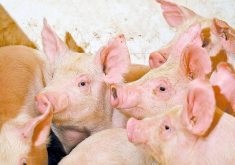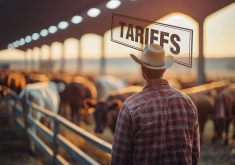A good, well-run chute plays a huge part in handling animals safely, reducing their stress and, more importantly, lowering the risk of injury or death for people working around the chute.
Jennifer Woods has seen the good and the bad.
The worst chutes I see are home-built or pieced together from parts of others, says Woods, a livestock-handling specialist from Blackie.
However, even well-functioning hydraulic chutes can be dangerous if those running them don t know what they re doing. It s easy to squeeze an animal too tight in a hydraulic squeeze, says Woods.
Read Also

Horns aren’t unlocking anytime soon on livestock transport standards
Standards good enough meet the definition of “humane” animal transportation still vary widely between what what industry wants, what animal rights advocates want and, between the two, what federal regulators decide is good enough.
You want the animal to be restrained but comfortable, not squeezed too tight. They can be injured in a chute that s too tight and it s stressful for them. Any time you stress an animal you re cutting into its productivity and your own bottomline, as well as making them harder to handle.
It is possible to over-squeeze a non-hydraulic squeeze, but those chutes are generally less damaging since they run on human power rather than hydraulics. V-shaped head catchers can be deadly for cattle that go down in the chute as the animal can easily choke in the narrow section of the head gate, says Woods.
Fortunately it seems head catchers are becoming less common. Woods likes the shoulder catches that hold an animal further back than a head catcher, and give you safe access to the neck for injections.
Those are especially good for one-person operations, says Woods. But, they re too narrow for horned animals. I like self-catching systems because if you have to work a head-catcher at the front of the chute, you re standing right at the point of the animal s shoulder, pushing them back that s a huge safety issue.
Good footing is essential. In any chute, one of the main goals is for the animal to stay on its feet and not slip against the bars, hurting itself or people around it. If you re looking for a good chute, make sure it has solid, non-slip flooring, advises Woods. And look for safe access to the animal.
A lot of times, simpler is better in chute design. Too many bells and whistles can make a chute less effective when you re using it, she says. Make sure there s no place an animal can get a foot, a leg or its head out through the access panels, even if it isn t perfectly held. And make sure a handler can t get an arm jammed against the bars if an animal kicks or moves. That s an easy way to break an arm with some chutes.
Some chutes have bars sticking out that can easily fell a person running around it.
I ve knocked myself out running into one of those levers, says Woods. A taller person could be clothes-lined. It s one of the most common injuries around chutes. Make sure any projecting bars are at chest level, even for a short person.
Back-up bars, such as a fence post or a metal bar, are another danger point and not just because it can allow a hand or fingers to be caught between it and the bars or the animal.
When you release an animal from the head gate, it backs up before it leaves through the gate, says Woods. If it the back bar doesn t hold for any reason it can throw the person running the back bar with a lot of force. A lot of people have been killed or hurt with back-up bars.
Woods likes to see a slide behind the chute and ideally a palpation cage where a person has a slide in front and behind them so they can work safely.
Good livestock handling includes people, facilities and equipment, says Woods. It s better for the safety of the people working around your animals and better for your bottomline. Onfarm animal welfare is already mandated for hogs and poultry. For beef it s part of slaughter and transport requirements and it will be coming to the farm. You can get ahead of that change and be ready for it.
———
On-farmanimalwelfareisalreadymandatedforhogs andpoultry.Forbeefit spartofslaughterandtransport requirementsanditwillbecomingtothefarm.














